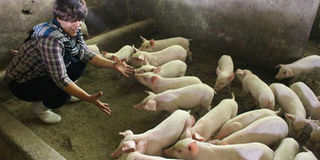Premium
Vet on Call: Beware of the purple pig disease, it wiped out multi-million farm in days

Pigs in a farm. African Swine Flu (ASF) is a fatal pig disease which has neither cure nor vaccine and is capable of wiping an entire flock in days. FILE PHOTO | NATION MEDIA GROUP
What you need to know:
- African Swine Fever (ASF) which is caused by a virus, is fatal and has no cure or vaccine.
- From its presentation, this was the type of ASF that could kill almost all the pigs.
- ASF is a stubborn disease and has frequent outbreaks.
- Keep your farm safe by curbing biting flies, ticks, and limit the number of vehicles and people visiting the farm as they could be the possible carriers of the disease.
I was in the middle of dinner some months ago with my family when my cell phone rang. My son looked at me and muttered, “Dad, you must first finish your food.”
Our children are accustomed to such calls that sometime come through my phone or that of my wife (who is also a vet) in the middle of important family time.
I recognised Judy’s voice and she was calling that night because her pigs had suddenly fallen ill. Judy’s description did not sound like an emergency, but I had to attend to her case as it was causing her distress.
Judy was a senior administrative assistant with a blue chip company in Nairobi and she had established a pig farm in Kahawa Sukari, Nairobi.
Her plan was to become a large-scale pig farmer after retirement.
Judy and her husband had initially invested Sh3.5 million in a piggery with 30 breeding pigs. In nine months, they had a total of 500 pigs and were happy with the progress.
The pigs periodically brought in a healthy income when Judy sold the six-month-old ones for slaughter.
On the several occasions I had visited her farm, I could tell she was really delighted with her achievement as she walked around the pig farm with a chief executive’s gait.
I continued with dinner to the delight of my family and left soon after for the 20-minute drive to Judy’s farm.
FATAL DISEASE
On the farm, I kitted myself in my dungarees, gumboots, thermometer and stethoscope and got the case history from her.
Judy told me the pigs were changing colour to red/purple. “Doctor, please tell me why I am now having purple pigs,” she said.
“I need to examine the pigs fully to make a diagnosis. We will also need to take samples for laboratory analysis,” I told her.
She asked me if I thought it was a fatal disease because she had never seen anything like that.
Judy’s question was tough because in my clinical mind, I knew she had every reason to be worried but in my professional mind, I knew I could not belt out a diagnosis without a thorough clinical examination and laboratory confirmation.
I examined 15 pigs which were huddled in a corner of a pen. The pigs had various degrees of skin discolouration from mild red to deep red to purple.
Some of them were bleeding under the skin and they had stopped eating. They all had a fever of between 41 and 41.5 degrees centigrade. The normal body temperature of a pig is 38 to 40 degrees centigrade.
The piggery’s night attendant informed me there were two other pens with sick animals. I followed him to the pens and I saw a group of about 40 pigs in two pens crowded in a corner showing various stages of the disease.
LEGAL OBLIGATION
Before I could call Judy’s attention to give her my findings and the next course of action, she asked me to examine her best breeding boar. The animal was a textbook case of African Swine Fever (ASF).
It was lying down, unable to stand.

A pigs farmer attends to her pigs in her Juja farm. Hotel left overs are usually a source of deadly diseases for pigs such as ASF and tuberculosis. FILE PHOTO | NATION MEDIA GROUP
The boar was purple on the skin and muzzle. It grunted in pain and discharged blood and froth from the nose. I turned to Judy and informed her that her pigs had a massive attack of swine fever.
The disease, which is caused by a virus, is a fatal one and has no cure or vaccine. From its presentation, this was the type of ASF that could kill almost all the pigs.
Unfortunately, that was not even bad enough for Judy. The government policy states that a farmer kills all animals on a farm (complete depopulation) in case of an outbreak, mind you without any compensation.
An infected farm should then be closed to pig farming for some time until the disease is put under control in the outbreak area.
As a legal obligation, I had to report the occurrence of the disease to the Veterinary Directorate and they would take over the management of the situation immediately.
In the meantime, no pig, except a sick one that we were to submit as live sample to the Veterinary Research Laboratories at Kabete, Nairobi, was to leave Judy’s farm.
“No one should be allowed to enter affected pig area until the arrival of the government staff,” says the policy.
I left the farm at about midnight feeling sorry for Judy. I knew her dream farm was gone with the massive ASF attack.
I wished she had heeded my advice and insured her pigs and stopped feeding them hotel left overs.
DREAM PIG FARM
Judy had failed to implement the two critical risk management steps. You see, hotel left overs are usually a source of deadly diseases for pigs such as ASF and tuberculosis.
As many other farmers, she had argued that hotel left overs were cheap feed for her pigs compared to the commercial ones.
The following morning, Judy and I took a sick piglet to the laboratory and I reported the suspicion of the presence of ASF on her farm.
Dr Mwangangi, who was the government duty pathologist at the laboratory, killed the piglet and did a post-mortem examination.
He concluded the pigs were having an ASF attack but the lab would still have to do a confirmation. In the following weeks, Judy’s farm was depopulated.
With that, her dream pig farm evaporated.
Initially, Judy stopped talking to me accusing me of having failed to assist her to clear the sick animals and sell off the seemingly healthy ones. I told her I was fulfilling my professional and legal obligation.
However, recently, I was pleasantly surprised when Judy called and told me she had realised it was her fault that she lost her dream pig farm. However, she has not gone back to farming after the heavy loss.
ASF is a stubborn disease and has frequent outbreaks, having attended to one late last year.
Keep your farm safe by curbing biting flies, ticks, and limit the number of vehicles and people visiting since they are possible carriers of the disease.





